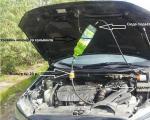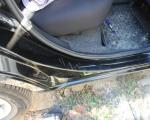Everything you need to know about flushing the engine cooling system with citric acid
Flushing the engine cooling system is one of the simplest procedures that even a beginner can handle. Moreover, if you figure out how to flush the engine cooling system with citric acid, then you can save money not only on workshop services, but also on expensive reagents.
The cooling system of cars does not need constant monitoring. As long as the machine is working properly, it is enough to flush the system no more than once every two years. But if the readings of the temperature sensor are too high, the engine is very hot, the fan is noisy, the pump is acting up or the stove is not working well, then it is better not to postpone the flushing.
Why should you flush the cooling system with citric acid?
From a wide selection of reagents on the market, at home it is better to give preference to "folk" and proven methods. And here is a list of the main advantages, why it is worth using citric acid, and not any other cleansing chemistry:
- Firstly, it will significantly reduce costs.
- Secondly, you do not have to breathe chemical fumes.
- Thirdly, citric acid does not corrode metal and is suitable for any type of radiator.
- Fourthly, this natural reagent perfectly copes with the most severe pollution and even scale.
- Fifth, the cleansing is gentle, without destroying the system and without wearing out the components of the car.
How to flush the engine cooling system with citric acid?
However, there are many disputes about how to flush the engine cooling system with citric acid. After all, the main thing is to do it right. Although measuring proportions in grams is not at all necessary. However, you need to adhere to certain quantitative indicators of the concentration of citric acid, so you can avoid unnecessary problems and losses. To do this, you need to remember only two things:
- Too little concentration of citric acid will not give the desired effect;
- Excessive consumption of lemongrass can damage the system.
The best option would be to use 30 grams of acid per 2 liters of distilled water. In order to flush the system, 10 liters of liquid is enough. This means that we need about 150 grams of citric acid to completely clean the cooling system.
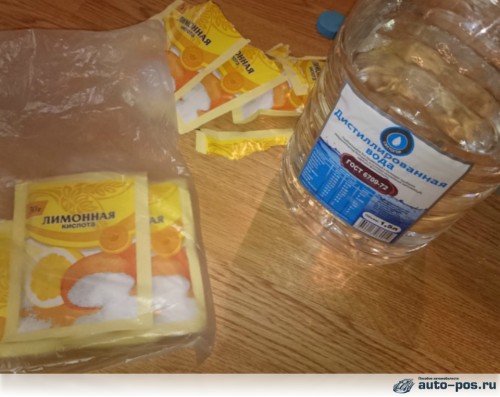
Preparation before starting work
In general, the procedure for cleaning the engine cooling system with citric acid is not much different from conventional flushing work. Before you start flushing, purchase distilled water (sold at any parts store). It costs a penny, so saving on water by clogging the system with new salt deposits is not desirable.
We heat part of the water, dissolve the entire volume of citric acid in it and wait until the liquid cools down again. At this time, you can do the antifreeze drain. To do this, a protective shield is unscrewed on the bottom of the machine. Under it you will see a radiator cap. If the coolant was filled recently, and you plan to use it after flushing, then before opening the valve on the radiator, you need to substitute a container to collect antifreeze. You can also use the container for accuracy.
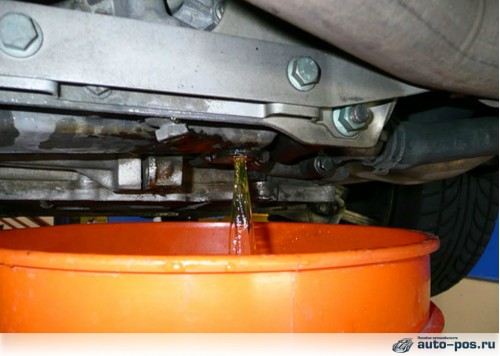
But to fill the cooler back or not, it will become clear as soon as you see the color of the liquid. Used antifreeze has a dark (dirty) color. You can control the rate of draining the liquid by unscrewing or tightening the plug on the expansion tank. After draining the fluid, to be more sure that there is no more antifreeze, the system can be purged through the expansion tank. Blowing is performed in 3-4 approaches with an interval of several minutes.
Next, we proceed directly to the question of how to flush the engine cooling system with citric acid. While the antifreeze was draining, the water with citric acid dissolved in it cooled down. Now it can be mixed with the remaining water, close the radiator cap and pour the mixture into the system. After that, we start the car and warm it up first at idle, and then for 10-15 minutes, adding a little gas.
Your further actions depend on the quality of the antifreeze you drained. If the liquid was very dirty, then it is better to drain the water with lemon after the first warm-up. And again fill the system with the same solution. If the system was not too dirty, then you should let the machine cool down and repeat the warm-up again. You can repeat the heating procedure with short breaks for 1-1.5 hours. The longer the contact of the lemon with the system, the better the result will be.
Remember that the next time you turn on the engine, the heating temperature of the engine can rise very quickly. In this case, turn off the ignition and open the expansion tank cap. The fact is that the air that has entered the system, heating up, pushes the water out. If you disconnect one hose of the throttle assembly, the level in the tank will immediately drop.
End of engine flush
When all work with citric acid is completed, drain the flushing fluid. In this case, the water should be light. If there are still a lot of impurities, washing with citric acid should be continued.
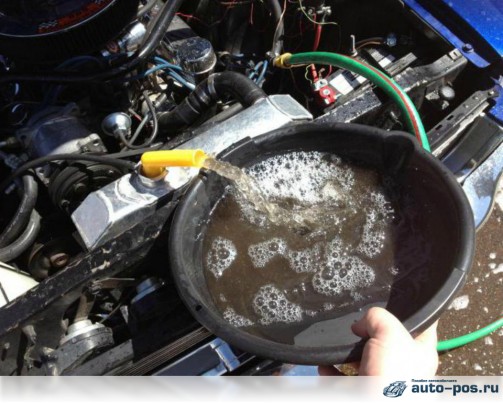
After the last drain of the lemon, we rinse the system 2-3 times with clean distilled water. We fill the system with new or previously used antifreeze, and check the engine for overheating, accelerating it to several thousand revolutions. If everything is done correctly, the thermometer will show the norm. After that, we carefully check whether the valve on the radiator is closed qualitatively, then we fasten the protective shield and check the hoses (if they were unscrewed).
As you can see, flushing the engine cooling system with citric acid is not difficult. But this will take a little more time than with chemical treatment with special means. But the result is worth it. After all, it is better to spend an extra hour of time on high-quality prevention than to later buy expensive components.

